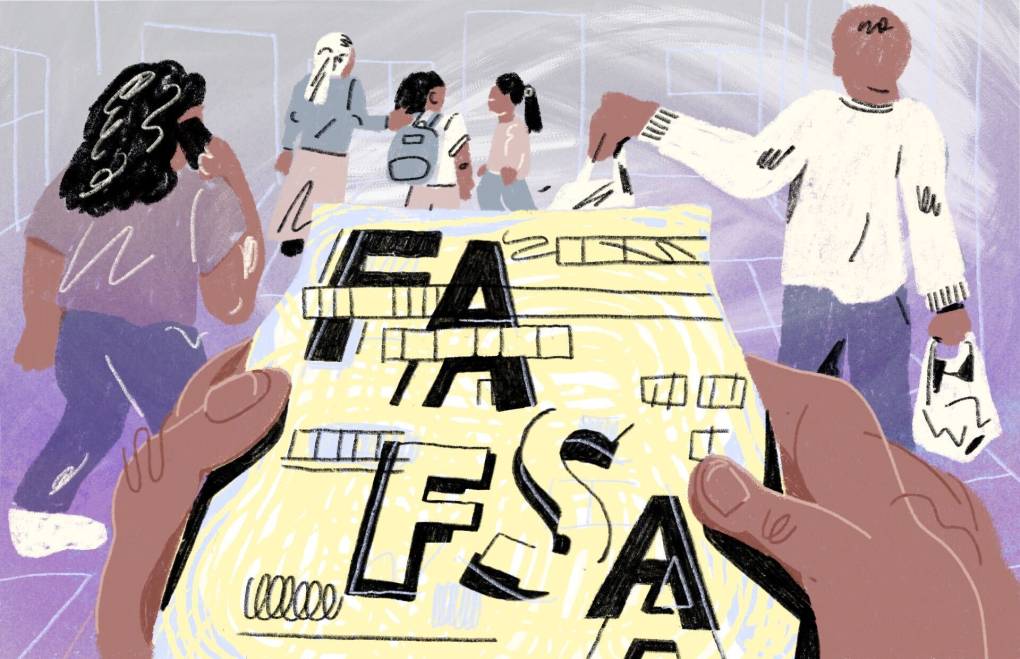Updated, 11:30 a.m. Thursday, April 11
At the best of times, the Free Application for Federal Student Aid — or FAFSA — can be a dreaded process for students across the country hoping to go to college. But this year, it got even more complicated when it was meant to become simpler.
The Department of Education, which manages the FAFSA, launched a revamped version of the form on Dec. 30, 2023, that aimed to streamline the infamously lengthy and detailed application. However, the federal agency has reported several complications in this year’s FASFSA rollout, leading to delays and much stress for students and their families.
In response to these delays, Gov. Gavin Newsom signed a bill on March 25 extending the deadline for California students to file their FAFSA to May 2, 2024, in order to be eligible for state financial aid. This means that students who are aiming to go to a four-year university in California can submit their applications by May 2 and still be eligible for financial aid. This also includes the CalGrant and the Middle Class Scholarship.
This extension by the state will come as a relief for many students amid a fraught nationwide rollout of the new FAFSA. Federal officials only began sending out students’ FAFSA data to colleges on March 10, months later than in years past. This delay — caused by a glitch in the form that wasn’t taking into account the economic inflation of recent years — has given schools less time to calculate students’ financial packages.
Additionally, students from mixed-status families — where a student has a Social Security number, but their parent doesn’t — could only complete their FAFSA until March 12 due to an entirely separate technical issue with the form.
The good news? Despite the multiple technical issues the new FAFSA has seen during its launch, some of the changes in the revamped form have made the process of filling out the form easier for students. Keep reading to learn more about the new FAFSA.
- Important deadlines and due dates for FAFSA in 2024
- How will FAFSA now measure a student’s financial need?
- Undocumented or from a mixed-status family? What you need to know about FAFSA and financial aid
- What to know if you’re also applying to private colleges
- My parents don’t have tax information available. How can I complete FAFSA?
Rest assured that there are resources and organizations available to help you with FAFSA — including the upcoming Cash for College Webinars organized by the California Student Aid Commission, scheduled throughout March and April. These are free and available to any student completing the FAFSA or the Dream Act application. The Commission also hosts Train the Trainer workshops to teach community partners also to host financial aid workshops.
We also have a guide to talking to your family about FAFSA — especially if they’re not usually comfortable talking about their finances with you.
There’s a new FAFSA timeline for 2024
In December 2020, Congress passed the FAFSA Simplification Act with the goal of making it easier for students to claim available financial aid and tackle the application’s infamous length and detailed, confusing tax questions — complications that have historically left billions of dollars of aid unclaimed.
In 2023, the Department of Education promised that the revamped FAFSA would launch sometime in December. And it did — but on Dec. 30. Because the form became available much later than normal, a lot of the steps in the financial aid process have been pushed back.
In the past, students applying for financial aid for the next academic year could start on their FAFSA around October, then apply for regular admission for most schools around December, and finally receive acceptance letters in March and April. Along with their acceptance letters, many schools also send out additional documents with information on annual costs and how much financial aid a student is eligible for.
This year, FAFSA came out when many students were rushing to get their college applications in before the deadline. And in January, the Department of Education confirmed that it needed to fix a major mistake in how FAFSA calculated a student’s financial need. The time needed to fix this glitch pushed back the date for the Department of Education to start sending students’ FAFSA data to colleges. This usually takes place at the end of January, but this year, federal officials started transferring student information until mid-March.
If you receive an acceptance letter that doesn’t include information on financial aid you qualify for, don’t panic. Email the school’s financial aid office and ask their timeline for sending out this information. They may be sending that letter out later than in previous years. Additionally, you can ask the college if they plan to push back the deadline for when they expect students to decide on whether to enroll in the school. For example, schools in the University of California and California State University systems have now pushed back this deadline to May 15.





